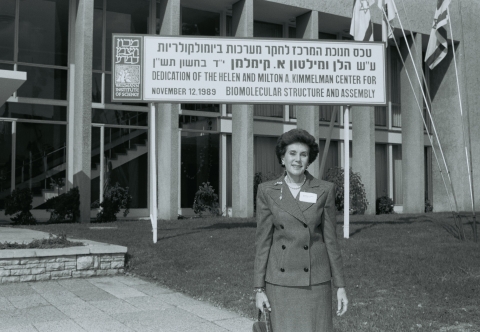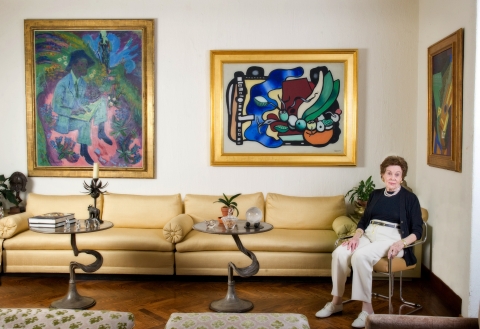The Kimmel Effect
People behind the science

Visionary philanthropy and friendship took Helen Kimmel to the Nobel Prize ceremony in Stockholm with Prof. Ada Yonath.
No one can win a Nobel Prize alone. There are, always, many partners along the way. But if you ask Prof. Ada Yonath of the Weizmann Institute of Science, the 2009 Nobel laureate in chemistry, about those who assisted her throughout the years in her scientific adventure, she says: “Many helped me along certain parts of the way. But only one was a real partner throughout this entire marathon. That was Helen Kimmel.”
In partnership with her first husband, Milton Kimmelman and, after his death in 1984, with her second husband, Martin Kimmel, Helen was the first major philanthropist to take a deep interest in Prof. Yonath’s scientific challenge: deciphering the structure of the ribosome, a tiny organelle that translates genetic information and builds proteins – the tools of life. In the 1980s, Helen began to invest in Prof. Yonath in a big way – at a time when others saw her as a dreamer trying to pursue a mission impossible.
, incumbent of the Martin and Helen Kimmel Professorial Chair in Structural Biology and director of the Helen and Milton A. Kimmelman Center for Biomolecular Structure and Assembly. “For me, Helen Kimmel has been that person. She paved my way.”
A family matter
It all began on a plane, when Helen and her first husband, Milton, took their first trip to Israel together in 1980. They met a couple who were going to the Weizmann Institute’s annual board meeting, and they invited the Kimmelmans to join them. There, they met Prof. Michael Sela, then-president of the Institute. The rest is history. A keen interest in science and math has played a fundamental role in Kimmel’s life, guiding her philanthropy and the choices she makes about the people with whom she surrounds herself. At the Weizmann Institute, her support over three decades has been based on warm and close relationships with its leadership and scientists. Her relationship with Weizmann, begun in partnership with her husband Milton; through her 20-year marriage to her second husband, Martin Kimmel, until his death in 2008; continues today. The Kimmelmans, then the Kimmels, have touched every corner of the Weizmann campus, but with a special predilection for the Faculty of Chemistry. Helen Lyttle was born in 1920 and grew up in Manhattan and Long Island, where she attended the prestigious Lawrence Woodmere Academy. There, “a wonderful teacher,” she says, named Edward Kasner kindled her interest in math “by explaining it all clearly and making it fun.” She kept his book, Mathematics and the Imagination, published by Simon & Schuster in 1940, at her side throughout her life and read it many times over.
Love of science and math was a family matter among the Lyttles. Her father didn’t finish high school before he immigrated to the US from England, but he “wanted the best education for us,” says Helen. He managed a successful dress business. Her mother took care of the four girls. One (now deceased) received a Ph.D. in botany and went on to a career in academia, first at Yale University and then at the University of Connecticut. A second sister, Ruth, who resides in the New York area, received a Ph.D. in math and went on to head the math department at Barnard College. A third sister died at a young age.
A math major, Helen attended Bryn Mawr College in Pennsylvania for two years, then transferred to Barnard, graduating at the height of World War II. She and her sisters were part of the one percent of American women who attended college in those years, and she admits feeling very lucky for the opportunity, especially at a time when European Jewry and the world were in turmoil.
She didn’t pursue a career, choosing instead to travel with her new husband, Milton. They had three children: Abby, Betsy and Peter.
A fateful meeting
The Kimmelmans’ first gift to the Institute was a general research grant; next, they established two career development chairs for promising young scientists. After Milton died in the spring of 1984, Helen wanted to memorialize him in a creative form. She got on a plane to Israel that summer, prepared to meet Institute computer scientists and fund a new project in memory of her husband. “But I got there and the computer scientists were abroad,” she recalls.
When Helen returned to the campus the next year, the Institute’s Scientific and Academic Advisory Committee (SAAC) had just completed its annual evaluation of a single research field within the Institute; that year the focus was biomolecular structure and assembly. Prof. Sela advised her that her dollars would best be spent on that area, and SAAC members Dr. Christian B. Anfinsen and Sir John Kendrew, both Nobel laureates in chemistry, concurred. “They told me: ‘This is where explosive developments will take place in the next 20 years.’ And indeed they were right,” recalls Helen after attending the Nobel Prize ceremony in Stockholm with her daughters and sharing the big moment with Prof. Yonath when she received the award.
That advice, and her awe of Prof. Yonath’s legendary persistence – she made 25,000 attempts to crystallize ribosomes - impelled her to focus her resources on the scientist. Helen established Yonath’s professorial chair in 1986 and the research center a year later. Research centers or institutes fund scientific investigations in a particular field and enable collaboration between scientists, both among research groups at Weizmann and elsewhere. By injecting funding into a particular field of research, Helen aimed to play a role in taking that research to a new level. The two women became fast friends; they keep in touch regularly and meet often. “Helen cares a great deal about the science she supports, and sees that it is going to make a difference in medicine, in understanding how the world works,” says Prof. Yonath. Helen says she gets “great satisfaction” from her close relationships with the scientists she supports, visiting them on campus and keeping abreast of their work by phone and e-mail throughout the year. And they are many: Kimmel funding has supported more than 60 scientists - through multiple vehicles. She has hosted many scientists at her home over the years - including at one fateful dinner in her Manhattan apartment in 1986.
Serendipity
Martin Kimmel had visited Weizmann with his son Adam, and he made a gift almost immediately upon returning to New York. That got him a place on Helen’s invitation list.
She hosted some 100 Weizmann scientists and donors, and other guests, that evening at a black-tie event. Martin accepted the invitation, but told his driver to keep the engine running, promising he’d be back downstairs in 15 minutes after a quick drink. When Helen answered the door, his plans changed. He called the driver and told him he was free to leave.
“Weizmann brought me Marty,” she says. The couple married two years later. Martin had built his wealth with his own wits, through his real estate business, Kimco Corp., one of the largest builders of strip malls in America. He retired in 1991 and spent his remaining years devoted to philanthropy, with Helen, until his death in 2008. Soon after their marriage, the Kimmels financed the acquisition of 50 acres of land adjacent to the Institute, increasing the campus area by 20 percent – a resounding confirmation of their faith in the Institute’s future. And since that 1990 gift, the couple’s footprint on the Weizmann campus became increasingly evident. Prof. Reshef Tenne was one of the first Weizmann Institute scientists to get to know Helen and Marty, and he has headed the Helen and Martin Kimmel Center for Nanoscale Science since its creation in 2003. “The Kimmels’ desire to give for the betterment of mankind had no limits,” he says.
The Kimmels’ “forward-thinking understanding of human nature” was what motivated them to establish the Kimmel Center for Archaeological Science, says Prof. Stephen Weiner, the Center’s director.
The Institute bestowed them with honorary Ph.D.’s – Helen in 1987 and Martin in 1997. For the Kimmels, who also have given generously to New York University and the Israel Museum, their contributions throughout the years have been closely tied to their trust in the people at the helm. “I bet a great deal on people, as I did with Ada, and with Daniel (Zajfman),” referring to the president. “Every institution faces challenges and sets its goals, but if the right ingredients are in place – the right people, as Weizmann has – then that’s the best possible recipe for success.”
The Kimmel Award for Innovative Investigation
The Helen L. and Martin S. Kimmel Award for Innovative Investigation is a $1 million grant, over five years, to one outstanding Weizmann Institute researcher each year. The award allows scientists to take on high-risk, high-gain projects – ones that traditional funding sources typically shy away from. Recipients to date and their research foci:
• Prof. Naama Barkai, Molecular Genetics and Physics of Complex Systems Department (2007): One of the pioneers of systems biology, a physicist-turnedbiologist who explores the design principles of living systems
• Prof. Yinon Rudich, Environmental Sciences and Energy Research Department (2008): Explores the fundamental chemistry and physics of climate, focusing on one of the major missing pieces of the global climate puzzle: aerosols
• Prof. Rafael Malach, Neurobiology Department (2009): Is defining how the brain processes sensory information into meaningful perception
• Prof. Lucio Frydman, Chemical Physics Department (2010): Develops new methods of nuclear magnetic resonance analysis to study disease
• Prof. Omer Reingold, Computer Science and Applied Mathematics Department (2011): Applies the concept of randomness to computer problems for use in algorithm design, cryptography, coding theory and network design
Prof. Malach on the Kimmel Award:
“It is one of the most innovative, visionary, and, ultimately, productive means to advance scientific research. The award created the opportunity for me to proceed with research that has recently yielded an important discovery in the field of mental disorders, in schizophrenia.”
Prof. Ada Yonath is funded by Helen & Milton A. Kimmelman Center for Biomolecular Structure & Assembly, which she heads. Prof. Yonath is the incumbent of the Martin S. and Helen Kimmel Professorial Chair of Structural Biology.
Prof. Stephen Weiner is funded by Dangoor Accelerator Mass Spectrometer Laboratory, Helen and Martin Kimmel Center for Archaeological Science which he heads, Estate of George & Beatrice F. Schwartzman. Prof. Weiner is the incumbent of the Dr. Walter and Dr. Trude Borchardt Professorial Chair in Structural Biology.

Helen Kimmel

Helen Kimmel








